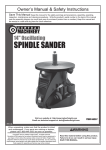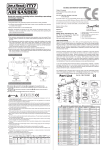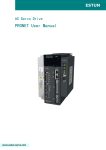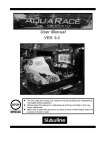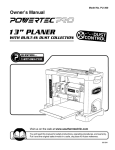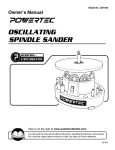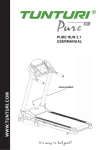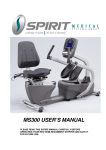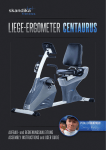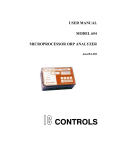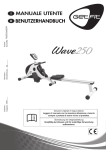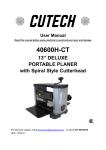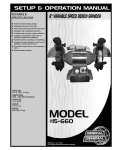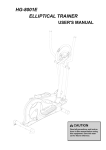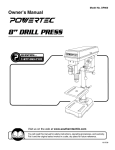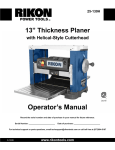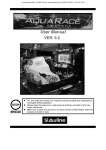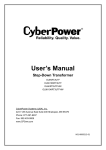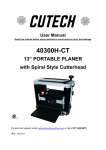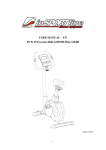Download 9” BAND SAW
Transcript
Model No. BS900 Owner’s Manual 9” BAND SAW QUESTION... 1•877•393•7121 Visit us on the web at www.southerntechllc.com You will need this manual for safety instructions, operating procedures, and warranty. Put it and the original sales invoice in a safe, dry place for future reference. 12-0506 TABLE OF CONTENTS SECTION PRODUCTION SPECIFICATIONS PAGE PREPARATION 1 Depth of throat at 90° . . . . . . . . . . . . . . . . . . . . . . . . . . . 9” Maximum depth of cut at 90°. . . . . . . . . . . . . . . . . . . 3-5⁄8” Work Preparation Work Area Preparation Tool Should Be Maintained Know How to Use Tool Maximum depth of cut at 45°. . . . . . . . . . . . . . . . . . . . . . 2” Table Size. . . . . . . . . . . . . . . . . . . . . . . . . . . . 11¾ x 11¾” Table Tilt. . . . . . . . . . . . . . . . . . . . . . . . . . . . . . . . 0° to 45° ASSEMBLY 2 Blade length. . . . . . . . . . . . . . . . . . . . . . . . . . . . . . . . . . 62” Unpackaging Install Table Assembly Mount Band Saw Power Source Grounding Instructions Extension Cords Motor OPERATION5 Blade width . . . . . . . . . . . . . . . . . . . . . . . . . . . . . . 1⁄8 - 3/8” Blade speed. . . . . . . . . . . . . . . . . . . . . . . . . . . . 2460 FPM Overall dimensions . . . . . . . . . . . . . . . . . . . . 20 x 13 x 29” 5 Description Safety Precautions ON/OFF Switch Replace Band Saw Blade Adjust Blade Tracking Mechanism Adjust Blade Tension Adjust Blade Guides Miter Gauge Blade Width Blade Pitch Contour Sawing Bevel Cutting MAINTENANCE 8 Cleaning Lubrication Keep Tool in Repair TROUBLESHOOTING Wheel diameter. . . . . . . . . . . . . . . . . . . . . . . . . . . . . . . 9.4” 9 PARTS ILLUSTRATION & LIST 10 WARRANTY 12 SAFETY RULES WARNING For your own safety, read and understand all warnings and operating instructions before using any tool or equipment. WARNING Some dust created by operation of power tool contains chemicals known to the State of California to cause cancer, birth defects or other reproductive harm. To reduce your exposure to these chemicals, work in a well ventilated area and work with approved safety equipment. Always wear OSHA/NIOSH approved, properly fitting face mask or respirator when using such tools. WARNING Failure to follow these rules may result in serious personal injury. Remember that being careless for even a fraction of a second can result in severe personal injury. WORK PREPARATION • Wear proper apparel. Do not wear loose clothing, gloves, neckties, rings, bracelets or other jewelry which may get caught in moving parts of the tool. • Nonslip protective footwear is recommended. Wear protective hair covering to contain long hair. • Wear eye and hearing protection. Always use safety glasses. Eye protection equipment should comply with ANSI Z87.1 standards. Hearing equipment should comply with ANSI S3.19 standards. • Wear face mask or dust mask if operation is dusty. • Be alert and think clearly. Never operate power tools when tired, intoxicated or when taking medications that cause drowsiness. WORK AREA PREPARATION • Keep work area clean. Cluttered work areas and benches invite accidents. • Work area should be properly lighted. • Do not use the machine in a dangerous environment. The use of power tools in damp or wet locations or in rain can cause shock or electrocution. • Three-prong plug should be plugged directly into properly grounded, three-prong receptacle. • Use the proper extension cord. Make sure your extension cord is in good condition. It should have grounding prong and should be of the correct gauge. • Keep children and visitors away. Your shop is a potentially dangerous environment. Children and visitors can be injured. • Make your workshop childproof with padlocks, master switches or remove switch keys to prevent any unintentional use of power tools. • It should have a grounding prong and should be of the correct gauge. 1 TOOL MAINTENANCE • Turn the machine "OFF", and disconnect the machine from the power source prior to inspection. • Maintain all tools and machines in peak condition. Keep tools sharp and clean for best and safest performance. • Follow instructions for lubricating and changing accessories. • Check for damaged parts. Check for alignment of moving parts, binding, breakage, mounting and any other condition that may affect tool's operation. • Poorly maintained tools and machines can further damage the tool or machine and/or cause injury. • A guard or any other part that is damaged should be repaired or replaced. Do not perform makeshift repairs. TOOL OPERATION • Avoid accidental start-up. Make sure that the tool is in the “OFF” position before plugging in. • Use the right tool for your job. Do not force your tool or attachment to do a job for which it was not designed. • Disconnect tool when changing parts. • Don't force the workpiece on the machine. Damage to the machine and/or injury may result. • Never leave tool running unattended. Turn the power off and do not leave tool until it comes to a complete stop. • Do not overreach. Loss of balance can make you fall into a working machine, causing injury. • Never stand on tool. Injury could occur if the tool tips, or if you accidentally contact the cutting tool. • Know your tool. Learn the tool’s operation, application and specific limitations before using it. • Use a proper extension cord of the correct gauge. Your extension cord should have a grounding prong, and should be in good condition. • Handle workpiece correctly. Keep hands away from moving parts. • Turn tool off if it jams. • Always feed workpiece against the direction of the sanding rotation. To maintain control, properly support long or wide work-pieces. CAUTION: Think safety! Safety is a combination of operator common sense and alertness at all times when tool is being used. WARNING Do not attempt to operate tool until it is completely assembled according to the instructions. ASSEMBLY 2 UNPACKAGING Refer to Figure 1. Figure 2 • Check for freight damage before opening the package. If freight damage is noticed, file claim with the carrier immediately. • Check to ensure all parts are present. Contact Customer Service Center immediately for missing parts. • This band saw comes mostly assembled. It requires some additional assembling, installation, and adjusment before use. • Locate the following parts before assembling: A. Mitre Gauge Assembly B. Table Assembly C. Locking Handle with Washer D. Table Locking Insert Assembly E. 10/12 mm Wrench, 2 Allen Wrench Figure 1 (not in scale) A D B C E F Lock Screw Handle Pointer Trunnion Knob MOUNT BAND SAW Refer to Figure 3 • The band saw must be installed in a well-lit area with correct power supply. • Four mounting holes are on the base of band saw. If pre-drilled holes do not exist on the bench surface, drill four holes. • Band saw can be installed on either a workbench or a tool stand by using bolts. Lock washers, and hex nuts. (mounting hardware not included) • The band saw must be bolted to a firm and level surface. • There must be enough clearance for the moving work piece during operation. There must be enough room for safe operation of the machine. Figure 3 CAUTION: Do not attempt assembly if parts are missing. Use operator’s manual to order replacement parts. INSTALL TABLE ASSEMBLY Refer to Figure 1 and 2 • • • • • Locate and remove the trunnion knob. Remove ths table locking insert assembly from the table. Place the table assembly onto the saw frame. Replace and secure the trunnion knob. Use the provided lock screw handle with washer to secure the table assembly to the saw frame. • Reinstall the Table Locking Insert Assembly. • After blade tracking and tension have been verified and the blade guides properly set, calibrate the table tilt position. Using a combination square, set the table perpendicular to the saw blade and zero the pointer of the tilt scale. Mounting Holes POWER SOURCE WARNING Do not connect to the power source until the machine is completely assembled. The machine is wired for 120 volts, 60 HZ alternating current. Before connecting the machine to the power source, make sure the switch is in the “OFF” position. GROUNDING INSTRUCTIONS A temporary 3-prong to 2-prong grounding adapter (see Figure 5) may be used to connect this plug to a matching 2-conductor receptacle as shown in figure 5. The temporary adapter should be used only until a properly grounded outlet can be installed by a qualified electrician. Figure 5 2-Prong Receptacle Grounded outlet Box Adapter WARNING Improper connection of equipment grounding conductor can result in the risk of electrical shock. • The machine should be grounded while in use to protect operator from electrical shock. • In the event of an electrical short circuit, grounding reduces the risk of electrical shock by providing an escape wire for the electric current. • This machine is equipped with an approved 3-conductor cord rated at 150V and a 3-prong grounding type plug (Figure 4) for your protection against shock hazards. • Grounding plug should be plugged directly into a properly installed and grounded 3-prong grounding-type receptacle, as shown (Figure 4) • The plug must be plugged into an outlet that is properly installed and grounded in accordance with all local codes and ordinances. • Check with a qualified electrician or service personnel if these instructions are not completely understood or if in doubt as to whether the tool is properly grounded. • Do not modify plug provided. If it will not fit in outlet, have proper outlet installed by a qualified electrician. Use only 3-wire extension cords, that have 3-prong grounding type plugs and matching 3-conductor receptacles that accept the machine’s plug, as show in Figure 4 Figure 4 3-Prong Receptacle Ground Outlet Box Properly Grounded Outlet Grounding Prong Grounding Prong 3-Prong Plug 3-Prong Plug Grounding Means In Canada, the use of temporary adapter is not permitted by the Canadian Electric Code. Where permitted, the rigid green tab or terminal on the side of the adapter must be securely connected to a permanent electrical ground such as a properly grounded water pipe, a properly grounded outlet box or a properly grounded wire system. • Many cover plate screws, water pipes and outlet boxes are not properly grounded. To ensure proper ground, grounding means must be tested by a qualified electrician. EXTENSION CORDS Use proper extension cords. Make sure the extension cord is in good condition. Use only 3-wire extension cords have 3-prong grounding type plugs and 3-pole receptacles which accept the tool plug. When using an extension cord, make sure to use one heavy enough to carry the current of the machine. An undersized cord will cause a drop in the voltage, resulting in loss of power and overheating. Use the table to determine the minimum wire size (A.W.G.) extension cord. Extension Cord Length Wire Size. . . . . . . . . . . . . . . . . . . . . . . . . . . . . . . . . A.W.G. Up to 25 ft.. . . . . . . . . . . . . . . . . . . . . . . . . . . . . . . . . . . . 18 25 to 50 ft. . . . . . . . . . . . . . . . . . . . . . . . . . . . . . . . . . . . 16 NOTE: Using extension cords over 50 ft. long is not recommended. MOTOR The 120 Volt AC motor has the following specifications: WARNING Do not permit fingers to touch the terminals of plug when installing or removing from outlet. • Inspect tool cords periodically, and if damaged, have repaired by an authorized service facility. • The conductor with insulation having an outer surface that is green with or without yellow stripes is the equipment- grounding conductor. If repair or replacement of the electric cord or plug is necessary, do not connect the green (or green and yellow) wire to a live terminal. ASSEMBLY Running the unit on voltages which are not within range may cause overheating and motor burn-out. Heavy loads require that voltage at motor terminals be no less than the voltage specified on nameplate. • Power supply to the motor is controlled by a locking rocker switch. Remove the key to prevent unauthorized use. Horsepower (Peak HP). . . . . . . . . . . . . . . . . . . . . . . . . 1/2 Voltage . . . . . . . . . . . . . . . . . . . . . . . . . . . . . . . . . . . . . 120 Amps . . . . . . . . . . . . . . . . . . . . . . . . . . . . . . . . . . . . . 2.5 Hertz . . . . . . . . . . . . . . . . . . . . . . . . . . . . . . . . . . . . . . 60 Phase . . . . . . . . . . . . . . . . . . . . . . . . . . . . . . . . . . . Single RPM . . . . . . . . . . . . . . . . . . . . . . . . . . . . . . . . . . . . 1725 3 OPERATION 4 DESCRIPTION •This 9” band saw has welded steel frame and aluminum table. It is designed to cut woods, plastics, and nonferrous metals. The solid durable structure will withstand continuous heavy-duty workloads for many years to come. • This band saw is equipped with miter gauge for various precision operations. • The versatile adjustable table can be easily tilted to any angle between 0 and 45 degrees. • Simple and quick saw blade tension adjustment. • Convenient and comprehensive saw blade tracking mechanism adjustment with view window for easy operation. • Dust collection port makes healthy working environment possible. • Powerful and durable Induction motor provides smooth and quiet operation. • This 9” saw blade features many versatile functions, convenient operation, easy maintenance, durable structure, and aesthetic design. It should provide reliable service and please the professionals and hobbyists alike. WARNING For your own safety, read the entire operating manual and safety instructions before using this tool. SAFETY PRECAUTIONS • Be aware of general power tool safety. Make sure all the safety rules are understood. • Disconnect the machine from power source whenever adjusting or replacing any parts. • Do not plug in unless switch is in “OFF” position. • Keep hands away from all moving parts. • Wear eye protection or face shield during operation. • Make sure all mobile parts move freely and are free from interference. • Never turn the machine “ON” with the workpiece contacting the blade. • Do not force cut. Slowing or stalling will overheat motor. • Blade guard and thrust bearings should be positioned and adjusted correctly to prevent sideways and rearward movement of the blade. • Properly adjust the blade tension, tracking, blade guides, and blade support bearings. • Use proper saw blade according to type of workpiece. • Allow the blade to reach full speed before cutting. • Do not attempt to remove jammed objects from saw blade until the switch is turned OFF and the blade has completely stopped. • Feed the workpiece through saw blade in a stable, slow, and constant manner. • Hold the workpiece steadily on the table during operation. •Turn switch off and disconnect power whenever the band saw is not in use. • Keep band saw maintained following maintenance instructions. • Lower blade guide to adjust above the intended workpiece before cutting. • The saw blade must be properly tension and tracking adjusted before use. ON/OFF SWITCH Refer to figure 6 The ON/OFF switch is located on front of band saw. To turn the machine ON, pull the switch to the up position. To turn the machine OFF, push the switch to the down position. NOTE: When the machine is not in use, the machine should be locked in the “OFF” position to prevent unauthorized use. •To lock the machine, turn the switch to “OFF” position. Pull the key out. The switch cannot be turned on without the key. • If the key is removed when the switch is at the “ON” position, the switch can be turned off but cannot be turned on again. • To unlock, place the key into the slot on switch unit until it snaps. Figure 6 REPLACE BAND SAW BLADE Refer to Figure 7 and 8 WARNING Turn the switch to the “OFF” position and disconnect the machine from power source. Do wear leather gloves when servicing band saw blade. Do not wear any gloves when operating the band saw • Turn blade tension knob counterclockwise to release blade tension. • Unlock door latches and open both the upper and lower doors. Figure 7 Tension Knob Blade Tension Lever Tracking Window Upper Guide Adjusting Knob Door Latch Tracking Knob Tensioning Spring Blade Guide Lock Knob •Properly adjust blade guide and support bearings before use. Figure 8 ADJUST BLADE TRACKING MECHANISM Refer to Figure 7 OPERATION •Turn the blade guide lock knob, located below the upper door latch, to release the upper blade guide assembly. • Turn the upper guide adjusting knob to lower the upper blade guide completely. • Carefully unsnap and swing open the blade guard panel. • Remove the table insert from the aluminum table. • Remove the table locking insert from the table slot. •Release the old blade and remove it through the table slot. • Replace with a new blade only. Inspect the new blade first. The teeth of blade should point down when installed. If not, turn the blade inside out. • Place the new blade through the aluminum table slot. • Slide the blade onto the upper and lower wheels. • Position blade between the upper and lower blade guides. • Loosen the socket head bolts holding the guide bearings and guide brackets for both upper and lower blade guides, push them back away from the blade and retighten. • Snap the blade guard panel into position. • Turn the blade tension lever clockwise until it stops. • Close the doors, check for good alignment and secure the latches. The doors need an appropriate seal for the dust collection system to work. • Repace the insert and locking insert assembly in the table. •Adjust blade tracking mechanism. • Check blade tension. Adjust if necessary. WARNING Watch for sharp blade edges when turning the wheels. Turn the switch to the OFF position and disconnect the machine from power source before adjusting blade tracking mechanism. • Unlock door latches and open the doors. • Manually rotate the drive wheel clockwise. The saw blade should travel downward at the table insert. Observe the blade movement from the viewing window on the side of upper door. • If the saw blade stays centered on both wheels, No further adjustment is necessary. • If the saw blade keeps tilting toward one side and is not in the center of idler wheel, the saw blade needs to be adjusted. • Loosen the lock nut of the tracking control knob on the right upper side panel to release the tracking control knob. • Carefully and slowly turn the idle wheel clockwise with the left hand and adjust the tracking control knob with the right hand until the blade is centered. • Turn tracking knob counterclockwise when blade rides away from the upper door. Turn tracking knob clockwise when blade rides toward the upper door. • Tighten the lock nut of tracking control knob when the blade is centered. • Close the upper door. • During the machine operation, the blade tracking can be observed from the viewing window. ADJUST BLADE TENSION Refer to Figure 7 • The blade tension is adjusted automatically by a spring-loaded blade tensioning mechanism and should require no frequent adjustment. However, there is blade tension knob on top of machine for fine tuning of the blade tension. • Over tensioned blade is prone to excessive wear and breakage. Under tensioned blade is prone to fluttering and movement during operation. • To adjust the blade tension, the blade cannot have any contact with the upper and lower blade guides. Raise the upper blade guide to the top. Move the blade guides away from the blade. • Turn the machine on. • Release the blade tension knob very slowly, ¼ turn at a time, until the blade starts to flutter. • Now tighten the blade tension knob very slowly until the blade stop fluttering. • Further tighten the blade tension knob for another ¼ turn. • Turn the machine off. • Properly adjust upper and lower blade guides before use. 5 OPERATION 6 ADJUST BLADE GUIDES Figure 11 Refer to Figure 9 to 11 • Blade guides should not be in contact with the blade when not in operation. • Adjust the blade guides after the blade tracking and blade tension have been properly adjusted. • The blade guide supports the blade with bearings on the rear and guide pins on both sides. They all should be adjusted to be 0.016” inches away from the blade. and adjusted so that they are located just behind the set in the teeth. For a quick gauge, fold a dollar bill in half twice and place it between the blade and the guide pins or the bearings. The thickness of 4x dollar bill is approximately 0.016”. • To adjust the guide pin position, loosen the screw on each guide pin block. Secure the screws after adjustment. Do the same for upper and lower blade guides. • Adjust the upper blade guide bearings position by loosening the socket head bolt behind the bearings and reposition the blade guide shaft. Tighten the bolt after adjustment. • Adjust the lower blade guide bearings position by loosening the socket head bolt behind the bearings and reposition the blade guide bracket. Tighten the bolt after adjustment. Figure 9 Guide Pin Screw Socket Head Bolt Bearing MITER GAUGE WARNING Do not use miter gauge and rip fence at the same time. Operator could be injured or/and the workpiece could be damaged because the blade might bind in the workpiece. •To adjust miter gauge, use a square with one edge against the miter gauge face and the other against the blade face. • Loosen the lock knob on the miter gauge and adjust to the right position. • Tighten the lock knob and loosen the pointer screw and adjust the pointer to 0° and tighten the screw on the pointer. BLADE WIDTH Bearing • Blade width is the distance from tip of a tooth to back of blade. The POWERTEC band saw blade width ranges from 1/8” to 3/8”. Curve cutting of 1/8” radius needs the blade width of 1/8”. Use blade width of ¼” for cutting radius of 5/8”. Use blade width of 3/8” for 1-1/4” cutting radius. Guide Pin BLADE PITCH Screw Figure 10 Bearing Socket Head Bolt •Pitch is the number of teeth per inch (TPI) or tooth size. • More teeth per inch will cut slower but produce smoother cutting surface; while fewer teeth per inch will cut rougher but faster. • For soft wood, the proper blade has between 6 to 8 teeth per inch. • For hard wood, use a blade with 8 to 12 teeth per inch. • Blade shocking occurs when pitch is too large and blade tooth encounters too much material. This can trip teeth from blade. CONTOUR SAWING • Contour cutting is guiding workpiece free-handed to produce curved shapes. • Turn the workpiece carefully so the blade follows without twisting. • Use a narrower blade to cut abrupt curves or make relief cuts. OPERATION BEVEL CUTTING • Beveled cutting is to tilt saw table for the desired degree. • Loosen locking handle to unlock table. • Rotate knob to tilt table to desired position. • Lock table by tightening locking handle. 7 MAINTENANCE WARNING 7 LUBRICATION Turn the switch to the “OFF” position and disconnect the machine from power source before servicing or disassembling any components. • The shielded ball bearings are permanently lubricated and require no further lubrication. • Small amount of oil can be applied to belt tension assembly and thread or sliding surfaces. CLEANING KEEP TOOL IN REPAIR •Keep machine and workplace clean. Avoid accumulation of sawdust on the tool. • Be certain motor is kept clean and free of dust. • Use soap and water to clean painted parts, rubber parts and plastic guards. • Keep wheels clean. Debris on wheels will cause poor tracking and blade slippage. • Make sure blade brush is in contact with blade to properly remove foreign particles from drive wheel. • If power cord is worn, cut or damaged in any way, do not operate the machine. • Replace any worn, damaged, or missing parts. Use parts listed to order parts. • Any attempt to repair motor may create a hazard unless repair is done by a qualified service technician. • Call the customer line at 1-877-393-7121. 8 TROUBLESHOOTING SYMPTOM POSSIBLE CAUSE(S) CORRECTIVE ACTION Motor will not start 1. Low voltage 2. Short circuit in line cord or plug 3. Short circuit in motor 4. Open circuit or loose connection in motor 5. Incorrect fuses or circuit breakers 6. Defective switch 7. Defective capacitor 1. Check power supply for proper voltage 2. Inspect line cord and plug for faulty insulation or shorted connection 3. Inspect connection on motor. 4. Inspect connection on motor 5. Replace with correct fuses or circuit breakers 6. Replace switch 7. Replace capacitor Motor stalls or fails to reach full speed 1. Power overload 2. Low voltage from power supply 3. Undersized line cord 4. Motor overload 5. Short circuit or loose connection in motor 6. Incorrect fuses or circuit breakers 1. Reduce workload on the power supply 2. Check power supply for proper voltage 3. Use line cord of adequate size or reduce length of wiring 4. Reduce load on motor 5. Inspect the connection in motor for loose or shorted connection 6. Replace with correct fuses or circuit breakers Motor overheats Motor overloaded Reduce load on motor. Turn off the machine until motor cools down Machine slows down while operating Applying too much pressure during operation Ease up on pressure Excessive vibration 1. Band saw not mounted securely to stand 2. Uneven stand surface 3. Worn belt 4. Pulley not aligned 5. Loose or damage blade 1. Tighten band saw to stand Rough cuts 1. Too much feed 2. Coarse blade 1. Reduce feed 2. Replace with fine blade Crooked cuts 1. Feed too fast 2. Blade is dull 3. Loose blade guide assembly or blade thrust bearing 4. Upper blade guide too far from workpiece 5. Workpiece not in square position 1. Reduce feed rate 2. Replace blade 3. Tighten blade thrust bearing with in 0.016” be hind blade back 4. Adjust blade guide to a proper position 1. Bad weld on blade 2. Force wide blade for small radius 3. Dull blade 4. Upper blade guide too high 5. Blade not tensioned properly 6. Improper blade wheel tracking 1. Replace blade 2. Replace to a narrow blade 3. Replace blade 4. Adjust blade guide 5. Tighten blade tension 6. Adjust blade tracking Excessive blade breakage 2. Level stand 3. Replace belt 4. Adjust pulley 5. Tighten or replace blade 5. Use miter gauge or tilt table to 90 ° 9” BAND SAW PARTS ILLUSTRATION 9 9" BAND SAW PARTS LIST 10 Key No. 1 2 3 4 5 6 7 8 9 10 11 12 13 14 15 16 17 18 19 20 21 22 23 24 25 26 27 28 29 30 31 32 33 34 35 36 37 38 39 40 41 42 43 44 45 46 47 48 49 50 51 52 53 54 55 56 57 58 59 Part No. BS900001 BS900002 BS900003 BS900004 BS900005 BS900006 BS900007 BS900008 BS900009 BS900010 BS900001 BS900012 BS900013 BS900014 BS900015 BS900016 BS900017 BS900018 BS900019 BS900020 BS900021 BS900022 BS900023 BS900024 BS900025 BS900026 BS900027 BS900028 BS900029 BS900030 BS900031 BS900032 BS900033 BS900034 BS900035 BS900036 BS900037 BS900038 BS900039 BS900040 BS900041 BS900042 BS900043 BS900044 BS900045 BS900046 BS900047 BS900048 BS900049 BS900050 BS900051 BS900052 BS900053 BS900054 BS900055 BS900056 BS900057 BS900058 BS900059 Description Specification Qty Handle Flat Washer ø6 Miter Gauge Scale Pan Head Screw M4x6 Flat Washer ø4 Pointer Side Bar Table Insert Aluminum Table Nut Spring Washer ø6 Wing Screw M6 Lock Screw M8x25L Flat Washer ø8 Hex Socket Head Screw M6x14L Trunnion Spacer Shoulder Bolt Spring Handle Spring Washer ø8 Hex Socket Head Screw M8x16L Flat Washer ø8 Set Screw M5xP0.8x6L Handle Washer ø16 Sleeve Eccentric Hex Socket Head Screw M6x16L Eccentric Shaft Hex Socket Head Screw M5xP0.8x10L Handle Spring Flat Washer ø8 Pan Head Screw M5x12L Handle Flat Washer ø8 Mount Square Nut Upper Blade Guide Spring Blade Guard Hex Socket Head Screw M5xP0.8x10L Hex Socket Head Screw M5xP0.8x16L Hex Socket Head Screw M5xP0.8x12L Screw Bearing Flat Washer ø5 Upper Bearing Bracket Upper Bearing Bracket Flat Head Screw M4x6L Upper Guide Block Lower Guide Block Pin Hex Socket Head Screw M6x8L Flat Wahser ø6 Lower Guide Mount Pan Head Screw M5x8L Upper Cabinet Support 1 1 1 1 1 1 1 1 1 1 1 1 1 1 2 1 2 1 1 1 4 4 4 1 1 1 1 1 1 1 2 1 1 2 2 1 1 1 1 1 1 1 2 1 1 2 2 14 1 1 4 1 1 4 2 2 1 9 1 Key No. 60 61 62 63 64 65 66 67 68 69 70 71 72 73 74 75 76 77 78 79 80 81 82 83 84 85 86 87 88 89 90 91 92 93 94 95 96 97 98 99 100 101 102 103 104 105 106 107 108 109 110 111 112 113 114 115 116 117 118 Part No. BS900060 BS900061 BS900062 BS900063 BS900064 BS900065 BS900066 BS900067 BS900068 BS900069 BS900070 BS900071 BS900072 BS900073 BS900074 BS900075 BS900076 BS900077 BS900078 BS900079 BS900080 BS900081 BS900082 BS900083 BS900084 BS900085 BS900086 BS900087 BS900088 BS900089 BS900090 BS900091 BS900092 BS900093 BS900094 BS900095 BS900096 BS900097 BS900098 BS900099 BS900100 BS900101 BS900102 BS900103 BS900104 BS900105 BS900106 BS900107 BS900108 BS900109 BS900110 BS900111 BS900112 BS900113 BS900114 BS900115 BS900116 BS900117 BS900118 Description Specification Hexagonal Nut M10 Spring Washer ø10 Tracking Adjustment Bracket Shaft Bearing Retaining Ring Idler Wheel Wheel Band Bearing Retaining Ring Pin Push Nut Tension Bracket Hex Socket Head Screw M5x6L Screw Bolt M8x80L Spring Flat Washer ø8 Handle Pan Head Screw M5x10L Flat Washer ø5 Dust Chute Cabinet Pan Head Screw M5x8L Ext Tooth Washer Hex Socket Head Screw M8x20L Flat Washer ø6 Motor Hex Socket Head Screw M8x20L Seal Hex Head Screw M6x16L Hexagonal Nut M6 Shaft Pulley Bearing Lower Wheel Bearing Retaining Ring Belt Tap Screw M5x16 Socket Head Bolt ø5 Pulley Flat Washer ø5 Flat Head Socket M5x8L Power Cord Strain Relief Switch Box Switch Pan Head Screw M5x10L Upper Door Latch Tap Screw ST4.2x6L Flat Washer ø4 Window Tap Screw ST4.8x10L Flat Washer ø5 Brush Lower Door Seal Hinges Qty 1 1 1 1 1 4 1 2 1 1 1 2 1 1 1 1 1 1 3 3 1 1 2 2 1 1 1 1 1 4 4 1 1 1 1 1 1 1 3 3 1 1 1 1 2 1 1 2 1 2 1 1 1 1 1 1 1 2 4 9” BAND SAW PARTS LIST Key No. Part No. 119 120 121 122 123 124 125 126 127 128 129 130 BS900119 BS900120 BS900121 BS900122 BS900123 BS900124 BS900125 BS900126 BS900127 BS900128 BS900129 BS900130 Description Specification Rivet Flat Head Screw ø4x8L Pinion Set Screw M4x4L Bracket Washer ø6 Handle Hex Socket Head Screw M5xP0.8x10L Plug Blade Hexagonal Nut M6 Hex Head Screw M6x23L Qty 8 8 1 1 1 1 1 2 1 1 1 1 Key No. 131 132 133 134 135 136 137 138 139 140 141 Part No. BS900131 BS900132 BS900133 BS900134 BS900135 BS900136 BS900137 BS900138 BS900139 BS900140 BS900141 11 Description Specification Tap Screw M4x10L Guard Pointer Flat Washer ø5 Hex Socket Head Screw M5xP0.8x8L Limit Plate Hex Wrench Hex Wrench Wrench Pan Head Screw M4x8L Blade Safe Cover Qty 1 1 1 1 1 1 1 1 1 2 1 13 WARRANTY Thank you for investing in a POWERTEC power tool. These products have been designed and manufactured to meet high quality standards and are guaranteed for domestic use against defects in workmanship or material for a period of 12 months from the date of purchase. This guarantee does not affect your statutory rights. SOUTHERN TECHNOLOGIES LLC. BENCH TOP AND STATIONARY POWER TOOL LIMITED 1 YEAR WARRANTY AND 30-DAY SATISFACTION GUARANTEE POLICY POWERTEC products are designed and manufactured by Southern Technologies LLC. All warranty communications should be directed to Southern Technologies LLC. 206 Terrace Dr. Mundelein, IL 60060, Attn: POWERTEC technical service; or by calling 1-877-393-7121 (toll free), 9 AM to 5 PM, Mondy through Friday, US Central Time. 30- DAY SATISFACTION GUARANTEE POLICY During the first 30 days after the date of purchase, if you are dissatisfied with the performance of this POWERTEC tool for any reason, you may return the tool to the retailer from which it was purchased for a full refund or exchange. You must present proof of purchase and return all original equipment packaged with the original product. The replacement tool will be covered by the limited warranty for the balance of the one year warranty period. LIMITED ONE YEAR WARRANTY This warranty covers all defects in workmanship or materials in this POWERTEC tool for a one year period from the date of purchase. This warranty is specific to this tool. Southern Technologies, LLC reserves the right to repair or replace the defective tool, at its discretion. HOW TO OBTAIN SERVICE To obtain service for this POWERTEC tool you must return it, freight prepaid, to an authorized POWERTEC service center for bench top and stationary power tools. You may obtain the location of the authorized service center nearest you by calling (toll free) 1-877-393-7121 or by logging on to the POWERTEC website at www.southerntechllc.com. When requesting warranty service, you must present the proof of purchase documentation, which includes a date of purchase. The authorized service center will either repair or replace any defective part, at our option at no charge to you. The repaired or replacement unit will be covered by the same limited warranty for the balance of one year warranty period. WHAT IS NOT COVERED This warranty applied to the original purchaser at retailer and may not be transferred. This warranty does not cover consumable items such as saw blades, knives, belts, discs, cooling blocks and sleeves. This warranty does not cover required service and part replacement resulting from normal wear and tear, including accessory wear. This warranty does not cover any malfunction, failure or defect resulting from: 1) misuse, abuse, neglect and mishandling not in accordance with the owner's manual. 2) damage due to accidents, natural disasters, power outage, or power overload. 3) commercial or rental use. 4) alteration, modification or reapair by other than an authorized service center for POWERTEC product. DISCLAIMER To the extent permitted by applicable law, all implied warranties, including warranties of MERCHANTABILITY or FITNESS FOR A PARTICULAR PURPOSE, are disclaimed. Any implied warranties, that cannot be disclaimed under state law are limited to one year from the date of purchase. Southern Technologies LLC. is not responsible for direct, indirect, incidental or consequential damages. Some states do not allow limitations on how long an implied warranty lasts and/or do not allow the exclusion or limitation of incidental or consequential damages, so the above limitations may not apply to you. This warranty gives you specific legal rights, and you may also have other rights which vary from state to state. Southern Technologies LLC., makes no warranties, representations, or promises as to the quality or performance of its power tools other than those specifically stated in this warranty. NOTE Southern Technologies, LLC 206 Terrace Drive Mundelein, Illinois 60060
















